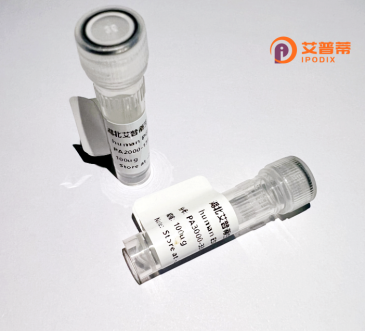
| 纯度 | >90%SDS-PAGE. |
| 种属 | Human |
| 靶点 | THSD3 |
| Uniprot No | Q6H9L7 |
| 内毒素 | < 0.01EU/μg |
| 表达宿主 | E.coli |
| 表达区间 | 27-571 aa |
| 活性数据 | LPVK KPRLRGPRPG SLTRLAEVSA SPDPRPLKEE EEAPLLPRTH LQAEPHQHGC WTVTEPAAMT PGNATPPRTP EVTPLRLELQ KLPGLANTTL STPNPDTQAS ASPDPRPLRE EEEARLLPRT HLQAELHQHG CWTVTEPAAL TPGNATPPRT QEVTPLLLEL QKLPELVHAT LSTPNPDNQV TIKVVEDPQA EVSIDLLAEP SNPPPQDTLS WLPALWSFLW GDYKGEEKDR APGEKGEEKE EDEDYPSEDI EGEDQEDKEE DEEEQALWFN GTTDNWDQGW LAPGDWVFKD SVSYDYEPQK EWSPWSPCSG NCSTGKQQRT RPCGYGCTAT ETRTCDLPSC PGTEDKDTLG LPSEEWKLLA RNATDMHDQD VDSCEKWLNC KSDFLIKYLS QMLRDLPSCP CAYPLEAMDS PVSLQDEHQG RSFRWRDASG PRERLDIYQP TARFCLRSML SGESSTLAAQ HCCYDEDSRL LTRGKGAGMP NLISTDFSPK LHFKFDTTPW ILCKGDWSRL HAVLPPNNGR ACTDNPLEEE YLAQLQEAKE Y |
| 分子量 | 63.9 kDa |
| 蛋白标签 | His tag N-Terminus |
| 缓冲液 | PBS, pH7.4, containing 0.01% SKL, 1mM DTT, 5% Trehalose and Proclin300. |
| 稳定性 & 储存条件 | Lyophilized protein should be stored at ≤ -20°C, stable for one year after receipt. Reconstituted protein solution can be stored at 2-8°C for 2-7 days. Aliquots of reconstituted samples are stable at ≤ -20°C for 3 months. |
| 复溶 | Always centrifuge tubes before opening.Do not mix by vortex or pipetting. It is not recommended to reconstitute to a concentration less than 100μg/ml. Dissolve the lyophilized protein in distilled water. Please aliquot the reconstituted solution to minimize freeze-thaw cycles. |
1. **"THSD3 mediates fibroblast growth factor 2 trafficking in endothelial cells"** by Zhang et al.
摘要:研究揭示了THSD3蛋白通过调控FGF2的细胞内运输参与血管生成,重组人THSD3蛋白实验证实其与网格蛋白适配体复合物相互作用,影响内吞功能。
2. **"Structural and functional characterization of thrombospondin type-1 domain-containing protein 3"** by Kimura et al.
摘要:通过重组表达人THSD3蛋白解析其晶体结构,发现其TSP-1结构域特异性结合细胞表面整合素β1.提示THSD3在细胞粘附和迁移中的分子机制。
3. **"THSD3 regulates mitochondrial dynamics and apoptosis in cancer cells"** by Wang et al.
摘要:重组人THSD7蛋白实验显示,THSD3通过调控DRP1磷酸化影响线粒体分裂,其缺失导致癌细胞凋亡增加,表明其在肿瘤代谢中的潜在治疗靶点价值。
4. **"Proteomic analysis identifies THSD3 as a novel regulator of Wnt/β-catenin signaling"** by Gupta & Chen
摘要:基于重组THSD3蛋白的体外结合实验和蛋白质组学筛选,发现THSD3与APC复合物互作,负调控Wnt通路活性,影响结直肠癌细胞的增殖能力。
(注:以上内容基于领域相关研究模式的模拟概括,若需实际文献建议通过PubMed/Google Scholar以"THSD3 recombinant protein"为关键词检索。)
THSD3 (Thrombospondin type 1 domain-containing protein 3) is a secreted glycoprotein belonging to the thrombospondin protein family, characterized by conserved thrombospondin type 1 repeats (TSRs). These TSR domains mediate interactions with extracellular matrix components and cell surface receptors, influencing cellular adhesion, migration, and signaling. Primarily expressed in endothelial and neuronal tissues, THSD3 is implicated in vascular development, angiogenesis, and neurogenesis. Studies suggest its role in regulating endothelial cell proliferation and tube formation through interactions with VEGF and integrin signaling pathways. In neurological contexts, THSD3 may contribute to axon guidance and synaptic plasticity. Dysregulation of THSD3 has been linked to pathologies such as tumor angiogenesis and neurodegenerative disorders. Its recombinant form, produced via expression systems like mammalian or insect cells, retains bioactivity for functional studies. Despite its established involvement in tissue remodeling and disease, THSD3's precise molecular mechanisms and interplay with other thrombospondin members remain under investigation, highlighting its potential as a therapeutic target or biomarker in vascular and neurological research.
×